Abstract
Ia molecules play a key role in antigen recognition by T lymphocytes. To analyze the structural features of the individual alpha and beta chains relevant to the assembly of intact Ia molecules, mouse fibroblasts were cotransfected with various combinations of haplotype- and isotype-mismatched Ia alpha/beta gene pairs. Two important points emerged. First, the level of surface expression of a given haplotype-mismatched A alpha A beta pair appears to depend upon the alpha and beta chain alleles involved. Second, transfection with some isotype-mismatched combinations such as Ed alpha Ad beta results in a significant level of surface expression of a stable mixed-isotype dimer, which also appears to be normally expressed at a low level by an Iad-positive B lymphoma. Moreover, a T-cell hybridoma specific for human gamma globulin and restricted by the Ed molecule was found to be efficiently stimulated by the Ed alpha Ad beta-positive transfectant in the presence of antigen. The stimulation was specifically inhibited by monoclonal antibodies directed to either the Ia or the L3T4 molecule. These findings suggest that the estimates of the potential number of Ia molecules available in an animal for restricting T-lymphocyte recognition of antigens must be revised.
Full text
PDF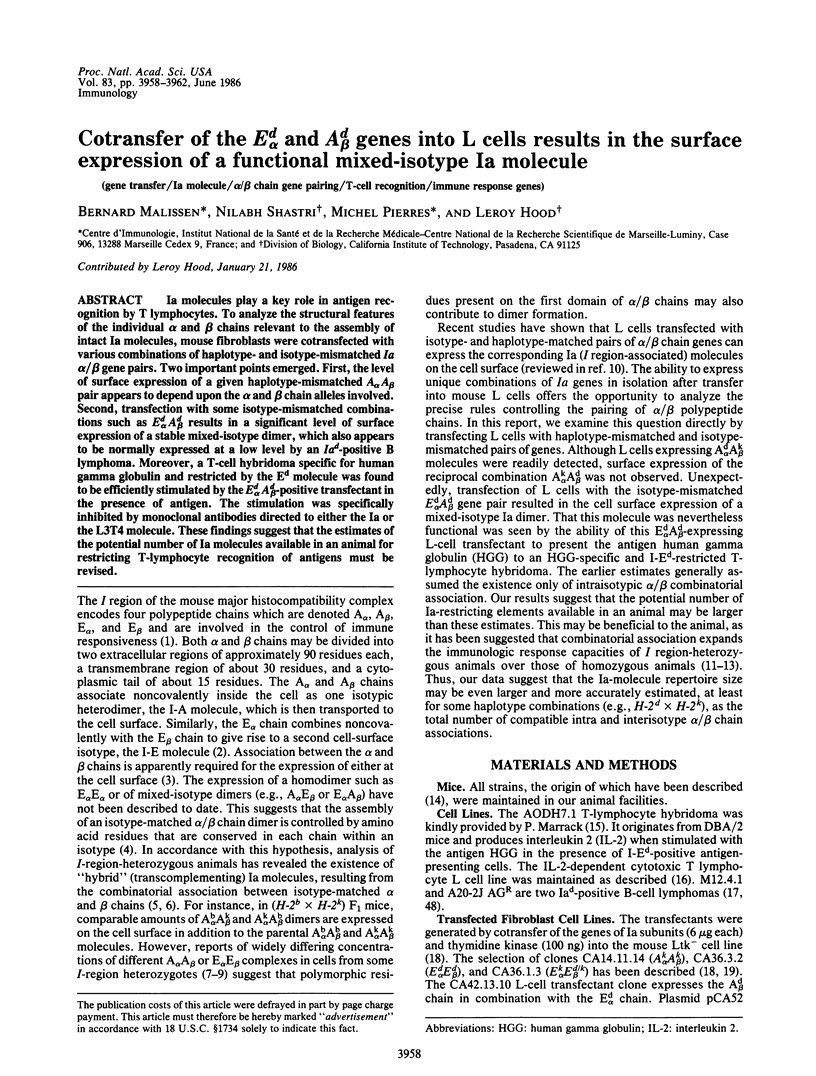
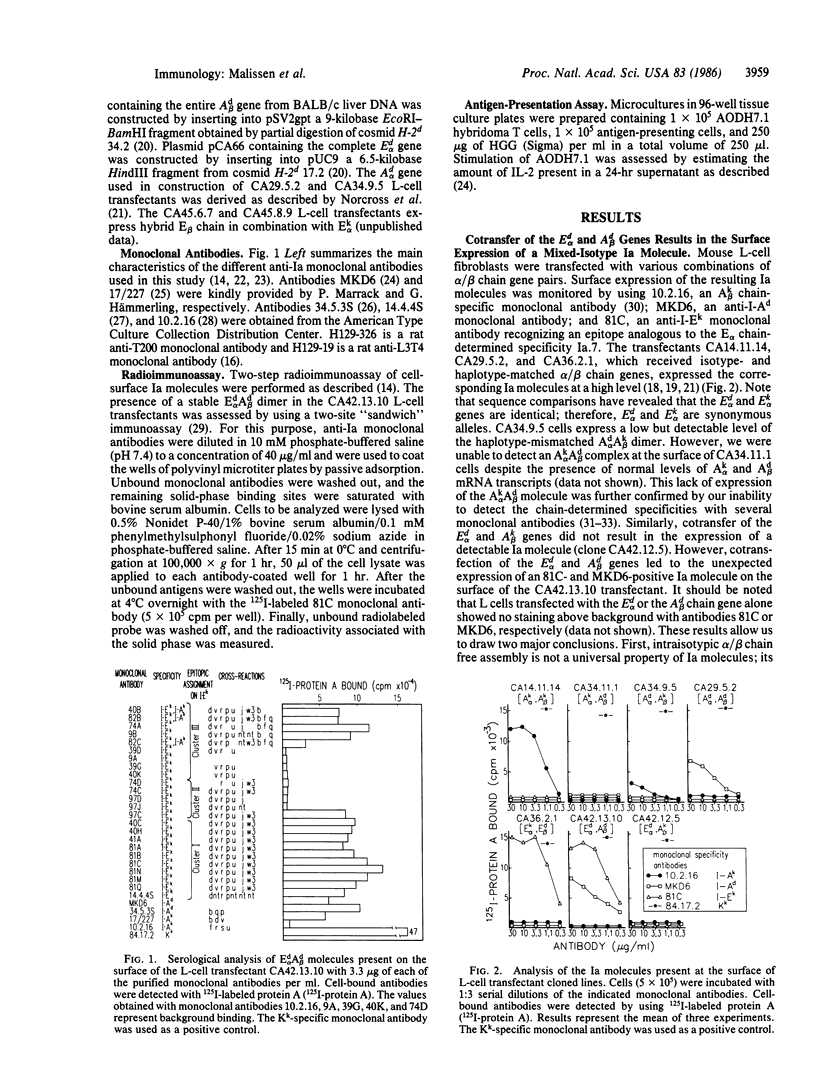
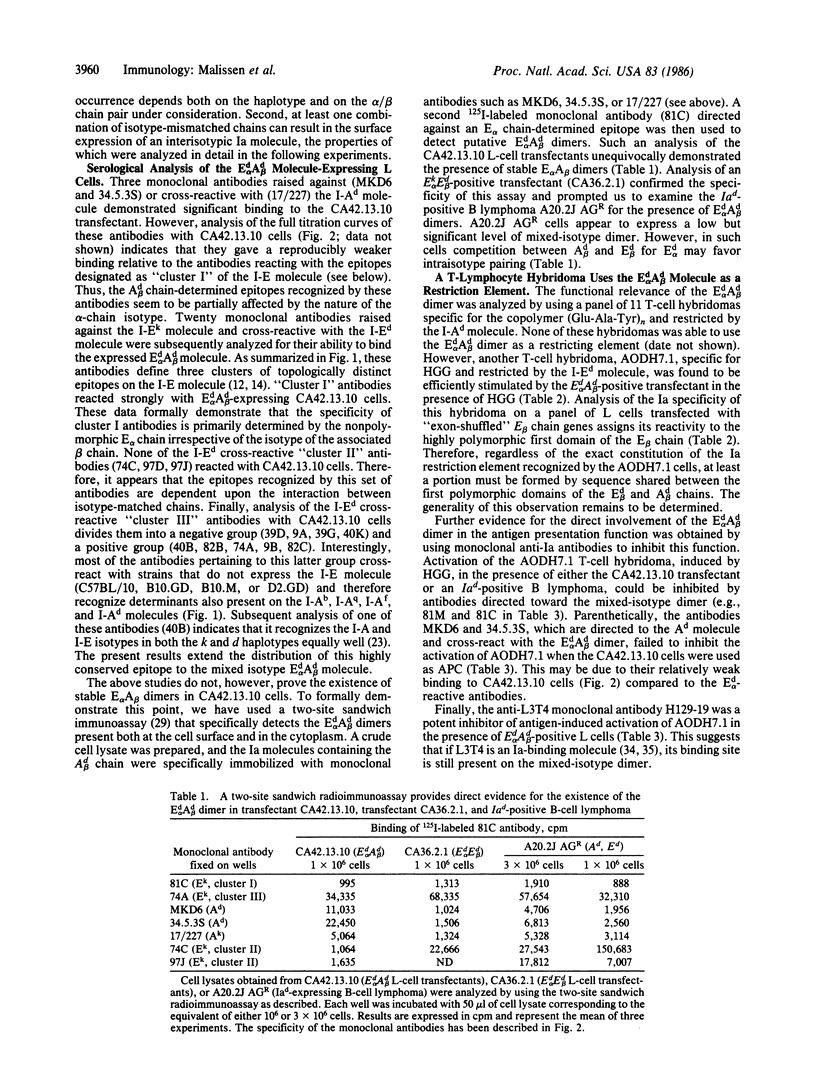
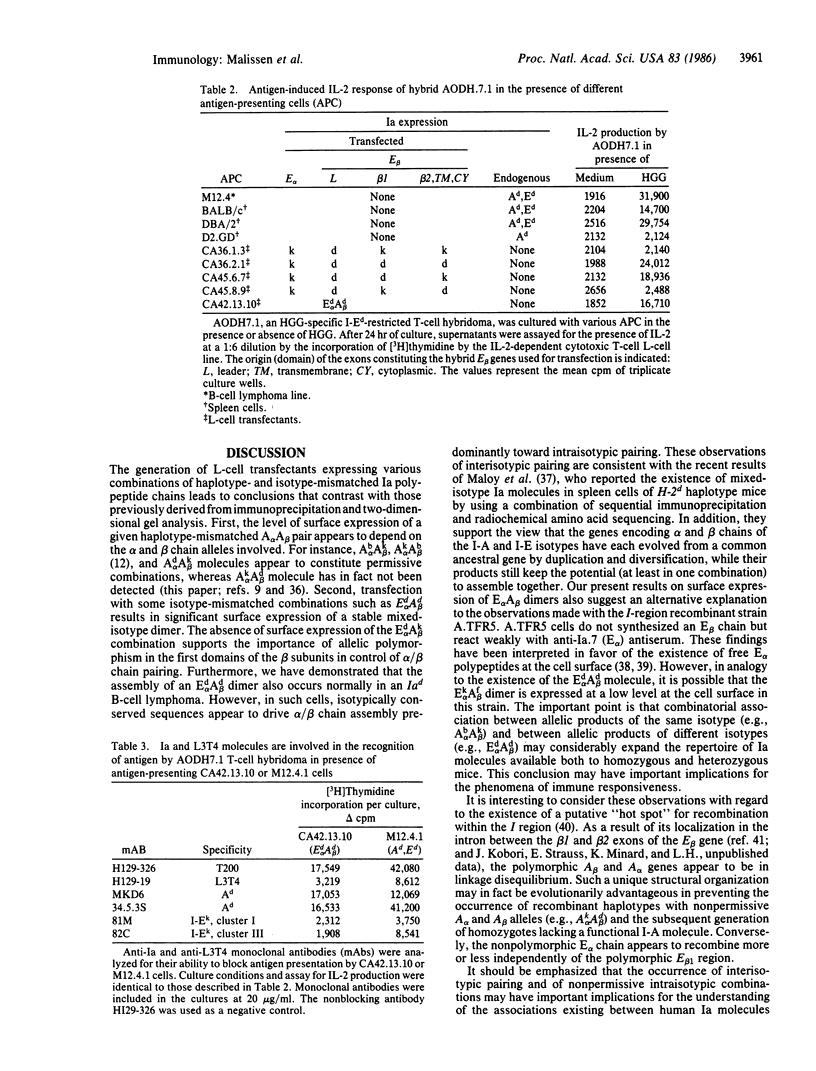
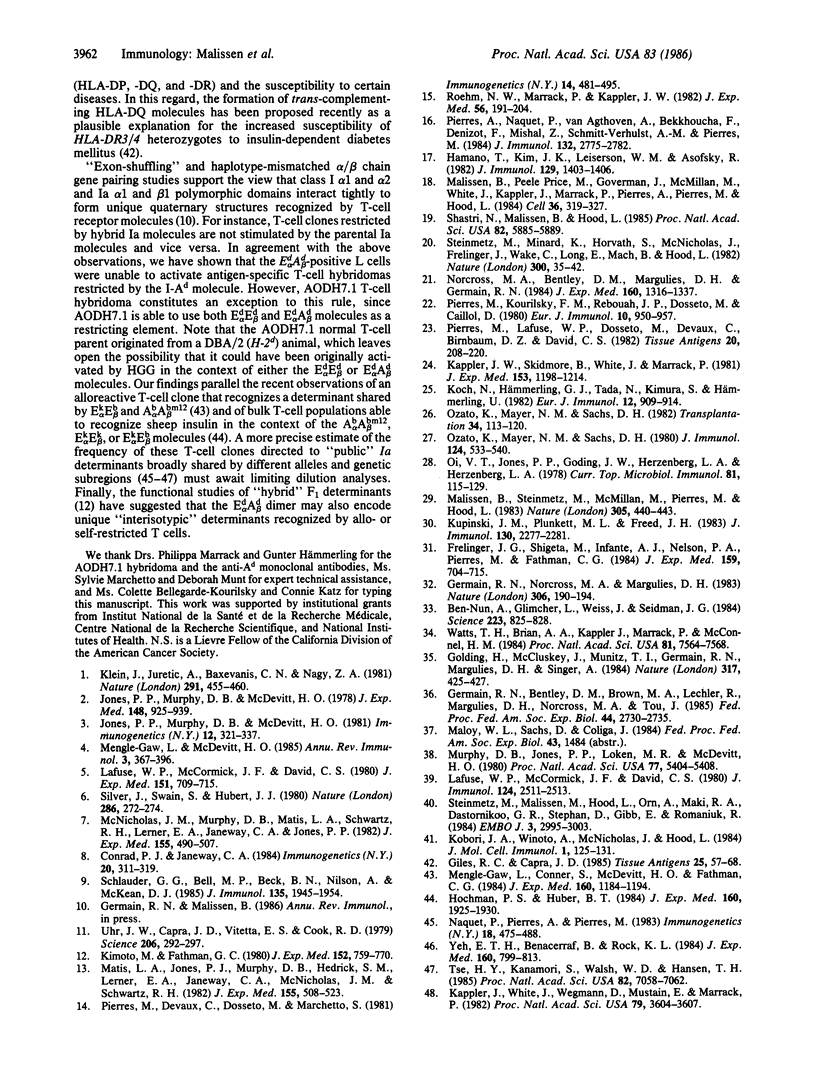
Selected References
These references are in PubMed. This may not be the complete list of references from this article.
- Ben-Nun A., Glimcher L. H., Weis J., Seidman J. G. Functional expression of a cloned I-A beta k gene in B-lymphoma cells. Science. 1984 Feb 24;223(4638):825–828. doi: 10.1126/science.6420890. [DOI] [PubMed] [Google Scholar]
- Conrad P. J., Janeway C. A., Jr The expression of I-Ed molecules in F1 hybrid mice detected with antigen-specific, I-Ed-restricted cloned T-cell lines. Immunogenetics. 1984;20(3):311–319. doi: 10.1007/BF00364212. [DOI] [PubMed] [Google Scholar]
- Frelinger J. G., Shigeta M., Infante A. J., Nelson P. A., Pierres M., Fathman C. G. Multiple functional sites on a single Ia molecule defined using T cell clones and antibodies with chain-determined specificity. J Exp Med. 1984 Mar 1;159(3):704–715. doi: 10.1084/jem.159.3.704. [DOI] [PMC free article] [PubMed] [Google Scholar]
- Germain R. N., Bentley D. M., Brown M. A., Lechler R., Margulies D. H., Norcross M. A., Tou J. Use of molecular techniques for analysis of Ia structure-function relationships. Fed Proc. 1985 Aug;44(11):2730–2735. [PubMed] [Google Scholar]
- Germain R. N., Norcross M. A., Margulies D. H. Functional expression of a transfected murine class II MHC gene. Nature. 1983 Nov 10;306(5939):190–194. doi: 10.1038/306190a0. [DOI] [PubMed] [Google Scholar]
- Giles R. C., Capra J. D. Biochemistry of MHC class II molecules. Tissue Antigens. 1985 Feb;25(2):57–68. doi: 10.1111/j.1399-0039.1985.tb00415.x. [DOI] [PubMed] [Google Scholar]
- Golding H., McCluskey J., Munitz T. I., Germain R. N., Margulies D. H., Singer A. T-cell recognition of a chimaeric class II/class I MHC molecule and the role of L3T4. Nature. 1985 Oct 3;317(6036):425–427. doi: 10.1038/317425a0. [DOI] [PubMed] [Google Scholar]
- Hamano T., Kim K. J., Leiserson W. M., Asofsky R. Establishment of B cell hybridomas with B cell surface antigens. J Immunol. 1982 Oct;129(4):1403–1406. [PubMed] [Google Scholar]
- Hochman P. S., Huber B. T. A class II gene conversion event defines an antigen-specific Ir gene epitope. J Exp Med. 1984 Dec 1;160(6):1925–1930. doi: 10.1084/jem.160.6.1925. [DOI] [PMC free article] [PubMed] [Google Scholar]
- Jones P. P., Murphy D. B., McDevitt H. O. Two-gene control of the expression of a murine Ia antigen. J Exp Med. 1978 Oct 1;148(4):925–939. doi: 10.1084/jem.148.4.925. [DOI] [PMC free article] [PubMed] [Google Scholar]
- Jones P. P., Murphy D. B., McDevitt H. O. Variable synthesis and expression of E alpha and Ae (E beta) Ia polypeptide chains in mice of different H-2 haplotypes. Immunogenetics. 1981;12(3-4):321–337. doi: 10.1007/BF01561674. [DOI] [PubMed] [Google Scholar]
- Kappler J. W., Skidmore B., White J., Marrack P. Antigen-inducible, H-2-restricted, interleukin-2-producing T cell hybridomas. Lack of independent antigen and H-2 recognition. J Exp Med. 1981 May 1;153(5):1198–1214. doi: 10.1084/jem.153.5.1198. [DOI] [PMC free article] [PubMed] [Google Scholar]
- Kappler J., White J., Wegmann D., Mustain E., Marrack P. Antigen presentation by Ia+ B cell hybridomas to H-2-restricted T cell hybridomas. Proc Natl Acad Sci U S A. 1982 Jun;79(11):3604–3607. doi: 10.1073/pnas.79.11.3604. [DOI] [PMC free article] [PubMed] [Google Scholar]
- Kimoto M., Fathman C. G. Antigen-reactive T cell clones. I. Transcomplementing hybrid I-A-region gene products function effectively in antigen presentation. J Exp Med. 1980 Oct 1;152(4):759–770. doi: 10.1084/jem.152.4.759. [DOI] [PMC free article] [PubMed] [Google Scholar]
- Klein J., Juretic A., Baxevanis C. N., Nagy Z. A. The traditional and a new version of the mouse H-2 complex. Nature. 1981 Jun 11;291(5815):455–460. doi: 10.1038/291455a0. [DOI] [PubMed] [Google Scholar]
- Kobori J. A., Winoto A., McNicholas J., Hood L. Molecular characterization of the recombination region of six murine major histocompatibility complex (MHC) I-region recombinants. J Mol Cell Immunol. 1984;1(2):125–135. [PubMed] [Google Scholar]
- Koch N., Hämmerling G. J., Tada N., Kimura S., Hämmerling U. Cross-blocking studies with monoclonal antibodies against I-A molecules of haplotypes b, d and k. Eur J Immunol. 1982 Nov;12(11):909–914. doi: 10.1002/eji.1830121103. [DOI] [PubMed] [Google Scholar]
- Kupinski J. M., Plunkett M. L., Freed J. H. Assignment of antigenic determinants to separated I-A kappa chains. J Immunol. 1983 May;130(5):2277–2281. [PubMed] [Google Scholar]
- Lafuse W. P., McCormick J. F., David C. S. Lack of gene complementation prevents expression of I-Ek in recombinant A.TFR5. J Immunol. 1980 May;124(5):2511–2513. [PubMed] [Google Scholar]
- Lafuse W. P., McCormick J. F., David C. S. Serological and biochemical identification of hybrid Ia antigens. J Exp Med. 1980 Mar 1;151(3):709–715. doi: 10.1084/jem.151.3.709. [DOI] [PMC free article] [PubMed] [Google Scholar]
- Malissen B., Price M. P., Goverman J. M., McMillan M., White J., Kappler J., Marrack P., Pierres A., Pierres M., Hood L. Gene transfer of H-2 class II genes: antigen presentation by mouse fibroblast and hamster B-cell lines. Cell. 1984 Feb;36(2):319–327. doi: 10.1016/0092-8674(84)90225-3. [DOI] [PubMed] [Google Scholar]
- Malissen B., Steinmetz M., McMillan M., Pierres M., Hood L. Expression of I-Ak class II genes in mouse L cells after DNA-mediated gene transfer. 1983 Sep 29-Oct 5Nature. 305(5933):440–443. doi: 10.1038/305440a0. [DOI] [PubMed] [Google Scholar]
- Matis L. A., Jones P. P., Murphy D. B., Hedrick S. M., Lerner E. A., Janeway C. A., Jr, McNicholas J. M., Schwartz R. H. Immune response gene function correlates with the expression of an Ia antigen. II. A quantitative deficiency in Ae:E alpha complex expression causes a corresponding defect in antigen-presenting cell function. J Exp Med. 1982 Feb 1;155(2):508–523. doi: 10.1084/jem.155.2.508. [DOI] [PMC free article] [PubMed] [Google Scholar]
- McNicholas J. M., Murphy D. B., Matis L. A., Schwartz R. H., Lerner E. A., Janeway C. A., Jr, Jones P. P. Immune response gene function correlates with the expression of an Ia antigen. I. Preferential association of certain Ae and E alpha chains results in a quantitative deficiency in expression of an Ae:E alpha complex. J Exp Med. 1982 Feb 1;155(2):490–507. doi: 10.1084/jem.155.2.490. [DOI] [PMC free article] [PubMed] [Google Scholar]
- Mengle-Gaw L., Conner S., McDevitt H. O., Fathman C. G. Gene conversion between murine class II major histocompatibility complex loci. Functional and molecular evidence from the bm 12 mutant. J Exp Med. 1984 Oct 1;160(4):1184–1194. doi: 10.1084/jem.160.4.1184. [DOI] [PMC free article] [PubMed] [Google Scholar]
- Mengle-Gaw L., McDevitt H. O. Genetics and expression of mouse Ia antigens. Annu Rev Immunol. 1985;3:367–396. doi: 10.1146/annurev.iy.03.040185.002055. [DOI] [PubMed] [Google Scholar]
- Murphy D. B., Jones P. P., Loken M. R., McDevitt H. O. Interaction between I region loci influences the expression of a cell surface Ia antigen. Proc Natl Acad Sci U S A. 1980 Sep;77(9):5404–5408. doi: 10.1073/pnas.77.9.5404. [DOI] [PMC free article] [PubMed] [Google Scholar]
- Naquet P., Pierres A., Pierres M. Dissection of the poly(glu60 ala30 tyr10) (GAT)-specific T-cell repertoire in H-2Ik mice. I. GAT plus self-I-Ak-reactive T-cell clones can recognize alloactivating and/or restriction determinants on nonself-Ia molecules. Immunogenetics. 1983;18(5):475–488. doi: 10.1007/BF00364389. [DOI] [PubMed] [Google Scholar]
- Norcross M. A., Bentley D. M., Margulies D. H., Germain R. N. Membrane Ia expression and antigen-presenting accessory cell function of L cells transfected with class II major histocompatibility complex genes. J Exp Med. 1984 Nov 1;160(5):1316–1337. doi: 10.1084/jem.160.5.1316. [DOI] [PMC free article] [PubMed] [Google Scholar]
- Oi V. T., Jones P. P., Goding J. W., Herzenberg L. A., Herzenberg L. A. Properties of monoclonal antibodies to mouse Ig allotypes, H-2, and Ia antigens. Curr Top Microbiol Immunol. 1978;81:115–120. doi: 10.1007/978-3-642-67448-8_18. [DOI] [PubMed] [Google Scholar]
- Ozato K., Mayer N. M., Sachs D. H. Monoclonal antibodies to mouse major histocompatibility complex antigens. Transplantation. 1982 Sep;34(3):113–120. doi: 10.1097/00007890-198209000-00001. [DOI] [PubMed] [Google Scholar]
- Ozato K., Mayer N., Sachs D. H. Hybridoma cell lines secreting monoclonal antibodies to mouse H-2 and Ia antigens. J Immunol. 1980 Feb;124(2):533–540. [PubMed] [Google Scholar]
- Pierres A., Naquet P., Van Agthoven A., Bekkhoucha F., Denizot F., Mishal Z., Schmitt-Verhulst A. M., Pierres M. A rat anti-mouse T4 monoclonal antibody (H129.19) inhibits the proliferation of Ia-reactive T cell clones and delineates two phenotypically distinct (T4+, Lyt-2,3-, and T4-, Lyt-2,3+) subsets among anti-Ia cytolytic T cell clones. J Immunol. 1984 Jun;132(6):2775–2782. [PubMed] [Google Scholar]
- Pierres M., Devaux C., Dosseto M., Marchetto S. Clonal analysis of B- and T-cell responses to Ia antigens. I. Topology of epitope regions on I-Ak and I-Ek molecules analyzed with 35 monoclonal alloantibodies. Immunogenetics. 1981 Dec;14(6):481–495. doi: 10.1007/BF00350120. [DOI] [PubMed] [Google Scholar]
- Pierres M., Kourilsky F. M., Rebouah J. P., Dosseto M., Caillol D. Distinct epitopes of Ik gene products identified by monoclonal antibodies. Eur J Immunol. 1980 Dec;10(12):950–957. doi: 10.1002/eji.1830101211. [DOI] [PubMed] [Google Scholar]
- Pierres M., Lafuse W. P., Dosseto M., Devaux C., Birnbaum D. Z., David C. S. Molecular specificity of a monoclonal anti-Ik alloantibody identifying a highly conserved determinant on mouse I-A, I-E and human DR antigens. Tissue Antigens. 1982 Sep;20(3):208–220. doi: 10.1111/j.1399-0039.1982.tb00347.x. [DOI] [PubMed] [Google Scholar]
- Roehm N. W., Marrack P., Kappler J. W. Antigen-specific, H-2-restricted helper T cell hybridomas. J Exp Med. 1982 Jul 1;156(1):191–204. doi: 10.1084/jem.156.1.191. [DOI] [PMC free article] [PubMed] [Google Scholar]
- Schlauder G. G., Bell M. P., Beck B. N., Nilson A., McKean D. J. The structure-function relationship of I-A molecules: a biochemical analysis of I-A polypeptides from mutant antigen-presenting cells and evidence of preferential association of allelic forms. J Immunol. 1985 Sep;135(3):1945–1954. [PubMed] [Google Scholar]
- Shastri N., Malissen B., Hood L. Ia-transfected L-cell fibroblasts present a lysozyme peptide but not the native protein to lysozyme-specific T cells. Proc Natl Acad Sci U S A. 1985 Sep;82(17):5885–5889. doi: 10.1073/pnas.82.17.5885. [DOI] [PMC free article] [PubMed] [Google Scholar]
- Silver J., Swain S. L., Hubert J. J. Small subunit of I-A subregion antigens determines the allospecificity recognized by a monoclonal antibody. Nature. 1980 Jul 17;286(5770):272–274. doi: 10.1038/286272a0. [DOI] [PubMed] [Google Scholar]
- Steinmetz M., Malissen M., Hood L., Orn A., Maki R. A., Dastoornikoo G. R., Stephan D., Gibb E., Romaniuk R. Tracts of high or low sequence divergence in the mouse major histocompatibility complex. EMBO J. 1984 Dec 1;3(12):2995–3003. doi: 10.1002/j.1460-2075.1984.tb02246.x. [DOI] [PMC free article] [PubMed] [Google Scholar]
- Steinmetz M., Minard K., Horvath S., McNicholas J., Srelinger J., Wake C., Long E., Mach B., Hood L. A molecular map of the immune response region from the major histocompatibility complex of the mouse. Nature. 1982 Nov 4;300(5887):35–42. doi: 10.1038/300035a0. [DOI] [PubMed] [Google Scholar]
- Tse H. Y., Kanamori S., Walsh W. D., Hansen T. H. The murine bm12 gene conversion provides evidence that T cells recognize predominantly Ia conformation. Proc Natl Acad Sci U S A. 1985 Oct;82(20):7058–7062. doi: 10.1073/pnas.82.20.7058. [DOI] [PMC free article] [PubMed] [Google Scholar]
- Uhr J. W., Capra J. D., Vitetta E. S., Cook R. G. Organization of the immune response genes. Science. 1979 Oct 19;206(4416):292–297. doi: 10.1126/science.113876. [DOI] [PubMed] [Google Scholar]
- Watts T. H., Brian A. A., Kappler J. W., Marrack P., McConnell H. M. Antigen presentation by supported planar membranes containing affinity-purified I-Ad. Proc Natl Acad Sci U S A. 1984 Dec;81(23):7564–7568. doi: 10.1073/pnas.81.23.7564. [DOI] [PMC free article] [PubMed] [Google Scholar]
- Yeh E. T., Benacerraf B., Rock K. L. Analysis of thymocyte MHC specificity with thymocyte hybridomas. J Exp Med. 1984 Sep 1;160(3):799–813. doi: 10.1084/jem.160.3.799. [DOI] [PMC free article] [PubMed] [Google Scholar]


